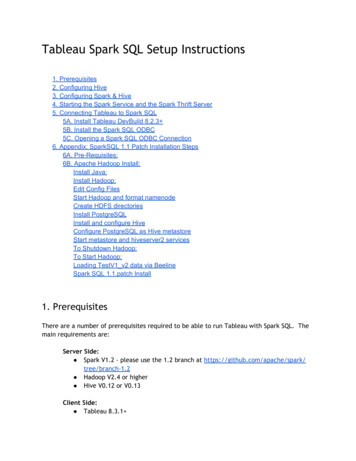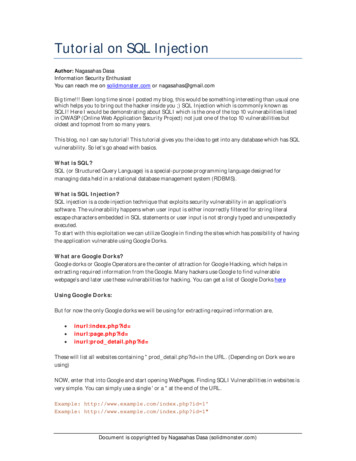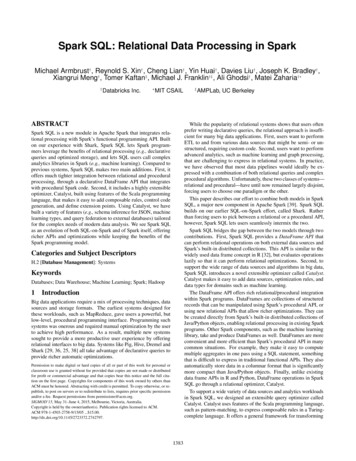
Transcription
Spark SQL: Relational Data Processing in SparkMichael Armbrust† , Reynold S. Xin† , Cheng Lian† , Yin Huai† , Davies Liu† , Joseph K. Bradley† ,Xiangrui Meng† , Tomer Kaftan‡ , Michael J. Franklin†‡ , Ali Ghodsi† , Matei Zaharia† †Databricks Inc. MIT CSAILABSTRACTAMPLab, UC BerkeleyWhile the popularity of relational systems shows that users oftenprefer writing declarative queries, the relational approach is insufficient for many big data applications. First, users want to performETL to and from various data sources that might be semi- or unstructured, requiring custom code. Second, users want to performadvanced analytics, such as machine learning and graph processing,that are challenging to express in relational systems. In practice,we have observed that most data pipelines would ideally be expressed with a combination of both relational queries and complexprocedural algorithms. Unfortunately, these two classes of systems—relational and procedural—have until now remained largely disjoint,forcing users to choose one paradigm or the other.This paper describes our effort to combine both models in SparkSQL, a major new component in Apache Spark [39]. Spark SQLbuilds on our earlier SQL-on-Spark effort, called Shark. Ratherthan forcing users to pick between a relational or a procedural API,however, Spark SQL lets users seamlessly intermix the two.Spark SQL bridges the gap between the two models through twocontributions. First, Spark SQL provides a DataFrame API thatcan perform relational operations on both external data sources andSpark’s built-in distributed collections. This API is similar to thewidely used data frame concept in R [32], but evaluates operationslazily so that it can perform relational optimizations. Second, tosupport the wide range of data sources and algorithms in big data,Spark SQL introduces a novel extensible optimizer called Catalyst.Catalyst makes it easy to add data sources, optimization rules, anddata types for domains such as machine learning.The DataFrame API offers rich relational/procedural integrationwithin Spark programs. DataFrames are collections of structuredrecords that can be manipulated using Spark’s procedural API, orusing new relational APIs that allow richer optimizations. They canbe created directly from Spark’s built-in distributed collections ofJava/Python objects, enabling relational processing in existing Sparkprograms. Other Spark components, such as the machine learninglibrary, take and produce DataFrames as well. DataFrames are moreconvenient and more efficient than Spark’s procedural API in manycommon situations. For example, they make it easy to computemultiple aggregates in one pass using a SQL statement, somethingthat is difficult to express in traditional functional APIs. They alsoautomatically store data in a columnar format that is significantlymore compact than Java/Python objects. Finally, unlike existingdata frame APIs in R and Python, DataFrame operations in SparkSQL go through a relational optimizer, Catalyst.To support a wide variety of data sources and analytics workloadsin Spark SQL, we designed an extensible query optimizer calledCatalyst. Catalyst uses features of the Scala programming language,such as pattern-matching, to express composable rules in a Turingcomplete language. It offers a general framework for transformingSpark SQL is a new module in Apache Spark that integrates relational processing with Spark’s functional programming API. Builton our experience with Shark, Spark SQL lets Spark programmers leverage the benefits of relational processing (e.g., declarativequeries and optimized storage), and lets SQL users call complexanalytics libraries in Spark (e.g., machine learning). Compared toprevious systems, Spark SQL makes two main additions. First, itoffers much tighter integration between relational and proceduralprocessing, through a declarative DataFrame API that integrateswith procedural Spark code. Second, it includes a highly extensibleoptimizer, Catalyst, built using features of the Scala programminglanguage, that makes it easy to add composable rules, control codegeneration, and define extension points. Using Catalyst, we havebuilt a variety of features (e.g., schema inference for JSON, machinelearning types, and query federation to external databases) tailoredfor the complex needs of modern data analysis. We see Spark SQLas an evolution of both SQL-on-Spark and of Spark itself, offeringricher APIs and optimizations while keeping the benefits of theSpark programming model.Categories and Subject DescriptorsH.2 [Database Management]: SystemsKeywordsDatabases; Data Warehouse; Machine Learning; Spark; Hadoop1‡IntroductionBig data applications require a mix of processing techniques, datasources and storage formats. The earliest systems designed forthese workloads, such as MapReduce, gave users a powerful, butlow-level, procedural programming interface. Programming suchsystems was onerous and required manual optimization by the userto achieve high performance. As a result, multiple new systemssought to provide a more productive user experience by offeringrelational interfaces to big data. Systems like Pig, Hive, Dremel andShark [29, 36, 25, 38] all take advantage of declarative queries toprovide richer automatic optimizations.Permission to make digital or hard copies of all or part of this work for personal orclassroom use is granted without fee provided that copies are not made or distributedfor profit or commercial advantage and that copies bear this notice and the full citation on the first page. Copyrights for components of this work owned by others thanACM must be honored. Abstracting with credit is permitted. To copy otherwise, or republish, to post on servers or to redistribute to lists, requires prior specific permissionand/or a fee. Request permissions from permissions@acm.org.SIGMOD’15, May 31–June 4, 2015, Melbourne, Victoria, Australia.Copyright is held by the owner/author(s). Publication rights licensed to ACM.ACM 978-1-4503-2758-9/15/05 . 83
trees, which we use to perform analysis, planning, and runtimecode generation. Through this framework, Catalyst can also beextended with new data sources, including semi-structured datasuch as JSON and “smart” data stores to which one can push filters(e.g., HBase); with user-defined functions; and with user-definedtypes for domains such as machine learning. Functional languagesare known to be well-suited for building compilers [37], so it isperhaps no surprise that they made it easy to build an extensibleoptimizer. We indeed have found Catalyst effective in enabling usto quickly add capabilities to Spark SQL, and since its release wehave seen external contributors easily add them as well.Spark SQL was released in May 2014, and is now one of themost actively developed components in Spark. As of this writing,Apache Spark is the most active open source project for big dataprocessing, with over 400 contributors in the past year. Spark SQLhas already been deployed in very large scale environments. Forexample, a large Internet company uses Spark SQL to build datapipelines and run queries on an 8000-node cluster with over 100PB of data. Each individual query regularly operates on tens ofterabytes. In addition, many users adopt Spark SQL not just for SQLqueries, but in programs that combine it with procedural processing.For example, 2/3 of customers of Databricks Cloud, a hosted servicerunning Spark, use Spark SQL within other programming languages.Performance-wise, we find that Spark SQL is competitive withSQL-only systems on Hadoop for relational queries. It is also upto 10 faster and more memory-efficient than naive Spark code incomputations expressible in SQL.More generally, we see Spark SQL as an important evolution ofthe core Spark API. While Spark’s original functional programmingAPI was quite general, it offered only limited opportunities forautomatic optimization. Spark SQL simultaneously makes Sparkaccessible to more users and improves optimizations for existingones. Within Spark, the community is now incorporating Spark SQLinto more APIs: DataFrames are the standard data representationin a new “ML pipeline” API for machine learning, and we hope toexpand this to other components, such as GraphX and streaming.We start this paper with a background on Spark and the goals ofSpark SQL (§2). We then describe the DataFrame API (§3), theCatalyst optimizer (§4), and advanced features we have built onCatalyst (§5). We evaluate Spark SQL in §6. We describe externalresearch built on Catalyst in §7. Finally, §8 covers related work.2Background and Goals2.1Spark OverviewThis code creates an RDD of strings called lines by reading anHDFS file, then transforms it using filter to obtain another RDD,errors. It then performs a count on this data.RDDs are fault-tolerant, in that the system can recover lost datausing the lineage graph of the RDDs (by rerunning operations suchas the filter above to rebuild missing partitions). They can alsoexplicitly be cached in memory or on disk to support iteration [39].One final note about the API is that RDDs are evaluated lazily.Each RDD represents a “logical plan” to compute a dataset, butSpark waits until certain output operations, such as count, to launcha computation. This allows the engine to do some simple queryoptimization, such as pipelining operations. For instance, in theexample above, Spark will pipeline reading lines from the HDFSfile with applying the filter and computing a running count, so thatit never needs to materialize the intermediate lines and errorsresults. While such optimization is extremely useful, it is alsolimited because the engine does not understand the structure ofthe data in RDDs (which is arbitrary Java/Python objects) or thesemantics of user functions (which contain arbitrary code).2.2Previous Relational Systems on SparkOur first effort to build a relational interface on Spark was Shark [38],which modified the Apache Hive system to run on Spark and implemented traditional RDBMS optimizations, such as columnarprocessing, over the Spark engine. While Shark showed good performance and good opportunities for integration with Spark programs,it had three important challenges. First, Shark could only be usedto query external data stored in the Hive catalog, and was thus notuseful for relational queries on data inside a Spark program (e.g., onthe errors RDD created manually above). Second, the only wayto call Shark from Spark programs was to put together a SQL string,which is inconvenient and error-prone to work with in a modularprogram. Finally, the Hive optimizer was tailored for MapReduceand difficult to extend, making it hard to build new features such asdata types for machine learning or support for new data sources.2.3Goals for Spark SQLWith the experience from Shark, we wanted to extend relationalprocessing to cover native RDDs in Spark and a much wider rangeof data sources. We set the following goals for Spark SQL:1. Support relational processing both within Spark programs (onnative RDDs) and on external data sources using a programmerfriendly API.Apache Spark is a general-purpose cluster computing engine withAPIs in Scala, Java and Python and libraries for streaming, graphprocessing and machine learning [6]. Released in 2010, it is to ourknowledge one of the most widely-used systems with a “languageintegrated” API similar to DryadLINQ [20], and the most activeopen source project for big data processing. Spark had over 400contributors in 2014, and is packaged by multiple vendors.Spark offers a functional programming API similar to other recentsystems [20, 11], where users manipulate distributed collectionscalled Resilient Distributed Datasets (RDDs) [39]. Each RDD isa collection of Java or Python objects partitioned across a cluster.RDDs can be manipulated through operations like map, filter,and reduce, which take functions in the programming languageand ship them to nodes on the cluster. For example, the Scala codebelow counts lines starting with “ERROR” in a text file:2. Provide high performance using established DBMS techniques.3. Easily support new data sources, including semi-structured dataand external databases amenable to query federation.4. Enable extension with advanced analytics algorithms such asgraph processing and machine learning.3Programming InterfaceSpark SQL runs as a library on top of Spark, as shown in Figure 1. It exposes SQL interfaces, which can be accessed throughJDBC/ODBC or through a command-line console, as well as theDataFrame API integrated into Spark’s supported programming languages. We start by covering the DataFrame API, which lets usersintermix procedural and relational code. However, advanced functions can also be exposed in SQL through UDFs, allowing them tobe invoked, for example, by business intelligence tools. We discussUDFs in Section 3.7.lines spark. textFile (" hdfs ://.")errors lines. filter (s s. contains (" ERROR "))println ( errors .count ())1384
JDBCConsoleSpark SQLwell as complex (i.e., non-atomic) data types: structs, arrays, mapsand unions. Complex data types can also be nested together tocreate more powerful types. Unlike many traditional DBMSes,Spark SQL provides first-class support for complex data types in thequery language and the API. In addition, Spark SQL also supportsuser-defined types, as described in Section 4.4.2.Using this type system, we have been able to accurately modeldata from a variety of sources and formats, including Hive, relationaldatabases, JSON, and native objects in Java/Scala/Python.User Programs(Java, Scala, Python)DataFrame APICatalyst OptimizerSpark3.3Resilient Distributed DatasetsUsers can perform relational operations on DataFrames using adomain-specific language (DSL) similar to R data frames [32] andPython Pandas [30]. DataFrames support all common relationaloperators, including projection (select), filter (where), join, andaggregations (groupBy). These operators all take expression objectsin a limited DSL that lets Spark capture the structure of the expression. For example, the following code computes the number offemale employees in each department.Figure 1: Interfaces to Spark SQL, and interaction with Spark.3.1DataFrame APIThe main abstraction in Spark SQL’s API is a DataFrame, a distributed collection of rows with the same schema. A DataFrameis equivalent to a table in a relational database, and can also bemanipulated in similar ways to the “native” distributed collectionsin Spark (RDDs).1 Unlike RDDs, DataFrames keep track of theirschema and support various relational operations that lead to moreoptimized execution.DataFrames can be constructed from tables in a system catalog(based on external data sources) or from existing RDDs of nativeJava/Python objects (Section 3.5). Once constructed, they can bemanipulated with various relational operators, such as where andgroupBy, which take expressions in a domain-specific language(DSL) similar to data frames in R and Python [32, 30]. EachDataFrame can also be viewed as an RDD of Row objects, allowingusers to call procedural Spark APIs such as map.2Finally, unlike traditional data frame APIs, Spark DataFramesare lazy, in that each DataFrame object represents a logical plan tocompute a dataset, but no execution occurs until the user calls a special “output operation” such as save. This enables rich optimizationacross all operations that were used to build the DataFrame.To illustrate, the Scala code below defines a DataFrame from atable in Hive, derives another based on it, and prints a result:employees.join(dept , employees (" deptId ") dept (" id ")). where ( employees (" gender ") " female "). groupBy (dept (" id"), dept (" name ")).agg( count (" name "))Here, employees is a DataFrame, and employees("deptId") isan expression representing the deptId column. Expression objectshave many operators that return new expressions, including the usualcomparison operators (e.g., for equality test, for greater than)and arithmetic ones ( , -, etc). They also support aggregates, suchas count("name"). All of these operators build up an abstract syntaxtree (AST) of the expression, which is then passed to Catalyst foroptimization. This is unlike the native Spark API that takes functionscontaining arbitrary Scala/Java/Python code, which are then opaqueto the runtime engine. For a detailed listing of the API, we referreaders to Spark’s official documentation [6].Apart from the relational DSL, DataFrames can be registered astemporary tables in the system catalog and queried using SQL. Thecode below shows an example:users . where ( users (" age ") 21). registerTempTable (" young ")ctx.sql (" SELECT count (*) , avg(age) FROM young ")ctx new HiveContext ()users ctx.table (" users ")young users.where(users (" age ") 21)println (young.count ())SQL is sometimes convenient for computing multiple aggregatesconcisely, and also allows programs to expose datasets throughJDBC/ODBC. The DataFrames registered in the catalog are stillunmaterialized views, so that optimizations can happen across SQLand the original DataFrame expressions. However, DataFrames canalso be materialized, as we discuss in Section 3.6.In this code, users and young are DataFrames. The snippetusers("age") 21 is an expression in the data frame DSL, whichis captured as an abstract syntax tree rather than representing a Scalafunction as in the traditional Spark API. Finally, each DataFramesimply represents a logical plan (i.e., read the users table and filterfor age 21). When the user calls count, which is an output operation, Spark SQL builds a physical plan to compute the final result.This might include optimizations such as only scanning the “age”column of the data if its storage format is columnar, or even usingan index in the data source to count the matching rows.We next cover the details of the DataFrame API.3.2DataFrame Operations3.4DataFrames versus Relational Query LanguagesWhile on the surface, DataFrames provide the same operations asrelational query languages like SQL and Pig [29], we found thatthey can be significantly easier for users to work with thanks to theirintegration in a full programming language. For example, userscan break up their code into Scala, Java or Python functions thatpass DataFrames between them to build a logical plan, and will stillbenefit from optimizations across the whole plan when they run anoutput operation. Likewise, developers can use control structureslike if statements and loops to structure their work. One user saidthat the DataFrame API is “concise and declarative like SQL, exceptI can name intermediate results,” referring to how it is easier tostructure computations and debug intermediate steps.To simplify programming in DataFrames, we also made APIanalyze logical plans eagerly (i.e., to identify whether the columnData ModelSpark SQL uses a nested data model based on Hive [19] for tablesand DataFrames. It supports all major SQL data types, includingboolean, integer, double, decimal, string, date, and timestamp, as1 We chose the name DataFrame because it is similar to structured datalibraries in R and Python, and designed our API to resemble those.2 These Row objects are constructed on the fly and do not necessarily represent the internal storage format of the data, which is typically columnar.1385
names used in expressions exist in the underlying tables, and whethertheir data types are appropriate), even though query results arecomputed lazily. Thus, Spark SQL reports an error as soon as usertypes an invalid line of code instead of waiting until execution. Thisis again easier to work with than a large SQL statement.3.5in other database systems. This feature has proven crucial for theadoption of the API.In Spark SQL, UDFs can be registered inline by passing Scala,Java or Python functions, which may use the full Spark API internally. For example, given a model object for a machine learningmodel, we could register its prediction function as a UDF:Querying Native Datasetsval model : LogisticRegressionModel .Real-world pipelines often extract data from heterogeneous sourcesand run a wide variety of algorithms from different programminglibraries. To interoperate with procedural Spark code, Spark SQL allows users to construct DataFrames directly against RDDs of objectsnative to the programming language. Spark SQL can automaticallyinfer the schema of these objects using reflection. In Scala and Java,the type information is extracted from the language’s type system(from JavaBeans and Scala case classes). In Python, Spark SQLsamples the dataset to perform schema inference due to the dynamictype system.For example, the Scala code below defines a DataFrame from anRDD of User objects. Spark SQL automatically detects the names(“name” and “age”) and data types (string and int) of the columns.ctx.udf. register (" predict ",(x: Float , y: Float ) model . predict ( Vector (x, y)))ctx.sql (" SELECT predict (age , weight ) FROM users ")Once registered, the UDF can also be used via the JDBC/ODBCinterface by business intelligence tools. In addition to UDFs thatoperate on scalar values like the one here, one can define UDFs thatoperate on an entire table by taking its name, as in MADLib [12], anduse the distributed Spark API within them, thus exposing advancedanalytics functions to SQL users. Finally, because UDF definitionsand query execution are expressed using the same general-purposelanguage (e.g., Scala or Python), users can debug or profile the entireprogram using standard tools.The example above demonstrates a common use case in manypipelines, i.e., one that employs both relational operators and advanced analytics methods that are cumbersome to express in SQL.The DataFrame API lets developers seamlessly mix these methods.case class User(name: String , age: Int)// Create an RDD of User objectsusersRDD spark. parallelize (List(User (" Alice", 22), User (" Bob", 19)))// View the RDD as a DataFrameusersDF usersRDD .toDF4To implement Spark SQL, we designed a new extensible optimizer,Catalyst, based on functional programming constructs in Scala.Catalyst’s extensible design had two purposes. First, we wanted tomake it easy to add new optimization techniques and features toSpark SQL, especially to tackle various problems we were seeingspecifically with “big data” (e.g., semistructured data and advancedanalytics). Second, we wanted to enable external developers toextend the optimizer—for example, by adding data source specificrules that can push filtering or aggregation into external storagesystems, or support for new data types. Catalyst supports bothrule-based and cost-based optimization.While extensible optimizers have been proposed in the past, theyhave typically required a complex domain specific language to specify rules, and an “optimizer compiler” to translate the rules intoexecutable code [17, 16]. This leads to a significant learning curveand maintenance burden. In contrast, Catalyst uses standard featuresof the Scala programming language, such as pattern-matching [14],to let developers use the full programming language while still making rules easy to specify. Functional languages were designed inpart to build compilers, so we found Scala well-suited to this task.Nonetheless, Catalyst is, to our knowledge, the first productionquality query optimizer built on such a language.At its core, Catalyst contains a general library for representingtrees and applying rules to manipulate them.3 On top of this framework, we have built libraries specific to relational query processing(e.g., expressions, logical query plans), and several sets of rulesthat handle different phases of query execution: analysis, logicaloptimization, physical planning, and code generation to compileparts of queries to Java bytecode. For the latter, we use anotherScala feature, quasiquotes [34], that makes it easy to generate codeat runtime from composable expressions. Finally, Catalyst offersseveral public extension points, including external data sources anduser-defined types.Internally, Spark SQL creates a logical data scan operator thatpoints to the RDD. This is compiled into a physical operator thataccesses fields of the native objects. It is important to note that thisis very different from traditional object-relational mapping (ORM).ORMs often incur expensive conversions that translate an entireobject into a different format. In contrast, Spark SQL accesses thenative objects in-place, extracting only the fields used in each query.The ability to query native datasets lets users run optimized relational operations within existing Spark programs. In addition, itmakes it simple to combine RDDs with external structured data. Forexample, we could join the users RDD with a table in Hive:views ctx. table (" pageviews ")usersDF .join(views , usersDF (" name ") views (" user "))3.6In-Memory CachingLike Shark before it, Spark SQL can materialize (often referred toas “cache") hot data in memory using columnar storage. Comparedwith Spark’s native cache, which simply stores data as JVM objects,the columnar cache can reduce memory footprint by an order ofmagnitude because it applies columnar compression schemes suchas dictionary encoding and run-length encoding. Caching is particularly useful for interactive queries and for the iterative algorithmscommon in machine learning. It can be invoked by calling cache()on a DataFrame.3.7Catalyst OptimizerUser-Defined FunctionsUser-defined functions (UDFs) have been an important extensionpoint for database systems. For example, MySQL relies on UDFs toprovide basic support for JSON data. A more advanced example isMADLib’s use of UDFs to implement machine learning algorithmsfor Postgres and other database systems [12]. However, databasesystems often require UDFs to be defined in a separate programmingenvironment that is different from the primary query interfaces.Spark SQL’s DataFrame API supports inline definition of UDFs,without the complicated packaging and registration process found3 Cost-based optimization is performed by generating multiple plans usingrules, and then computing their costs.1386
Rules (and Scala pattern matching in general) can match multiple patterns in the same transform call, making it very concise toimplement multiple transformations at once:AddAttribute(x)Literal(1)Addtree. transform {case Add( Literal (c1), Literal (c2 )) Literal (c1 c2)case Add(left , Literal (0)) leftcase Add( Literal (0) , right ) right}Literal(2)Figure 2: Catalyst tree for the expression x (1 2).4.1TreesThe main data type in Catalyst is a tree composed of node objects.Each node has a node type and zero or more children. New nodetypes are defined in Scala as subclasses of the TreeNode class. Theseobjects are immutable and can be manipulated using functionaltransformations, as discussed in the next subsection.As a simple example, suppose we have the following three nodeclasses for a very simple expression language:4 Literal(value: Int): a constant value Attribute(name: String): an attribute from an input row, e.g., “x” Add(left: TreeNode, right: TreeNode): sum of two expressions.These classes can be used to build up trees; for example, the treefor the expression x (1 2), shown in Figure 2, would be representedin Scala code as follows:4.3Add( Attribute (x), Add( Literal (1), Literal (2)))4.2In practice, rules may need to execute multiple times to fullytransform a tree. Catalyst groups rules into batches, and executeseach batch until it reaches a fixed point, that is, until the tree stopschanging after applying its rules. Running rules to fixed pointmeans that each rule can be simple and self-contained, and yetstill eventually have larger global effects on a tree. In the exampleabove, repeated application would constant-fold larger trees, suchas (x 0) (3 3). As another example, a first batch might analyzean expression to assign types to all of the attributes, while a secondbatch might use these types to do constant folding. After eachbatch, developers can also run sanity checks on the new tree (e.g., tosee that all attributes were assigned types), often also written viarecursive matching.Finally, rule conditions and their bodies can contain arbitraryScala code. This gives Catalyst more power than domain specificlanguages for optimizers, while keeping it concise for simple rules.In our experience, functional transformations on immutable treesmake the whole optimizer very easy to reason about and debug.They also enable parallelization in the optimizer, although we donot yet exploit this.Using Catalyst in Spark SQLWe use Catalyst’s general tree transformation framework in fourphases, shown in Figure 3: (1) analyzing a logical plan to resolvereferences, (2) logical plan optimization, (3) physical planning, and(4) code generation to compile parts of the query to Java bytecode.In the physical planning phase, Catalyst may generate multipleplans and compare them based on cost. All other phases are purelyrule-based. Each phase uses different types of tree nodes; Catalystincludes libraries of nodes for expressions, data types, and logicaland physical operators. We now describe each of these phases.RulesTrees can be manipulated using rules, which are functions from atree to another tree. While a rule can run arbitrary code on its inputtree (given that this tree is just a Scala object), the most commonapproach is to use a set of pattern matching functions that find andreplace subtrees with a specific structure.Pattern matching is a feature of many functional languages thatallows extracting values from potentially nested structures of algebraic data types. In Catalyst, trees offer a transform methodthat applies a pattern matching function recursively on all nodes ofthe tree, transforming the ones that match each pattern to a result.Fo
analytics libraries in Spark (e.g., machine learning). Compared to previous systems, Spark SQL makes two main additions. First, it offers much tighter integration between relational and procedural processing, through a declarative DataFrame API that integrates with procedural Spa
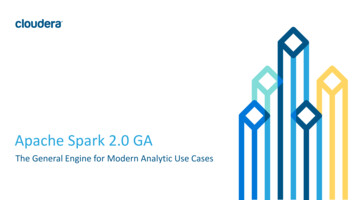

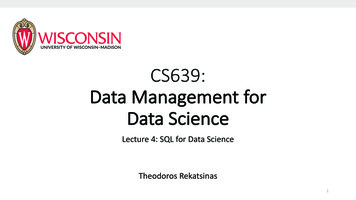
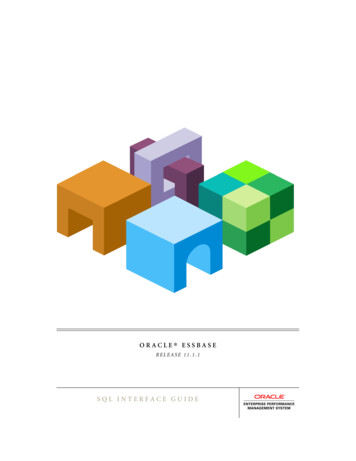
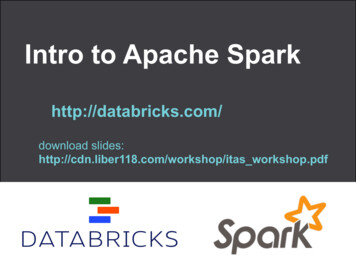



![SQL Server TSQL [Read-Only]](/img/17/sql-server-tsql.jpg)
